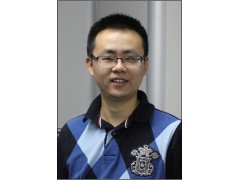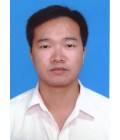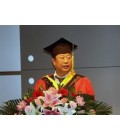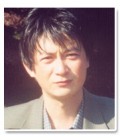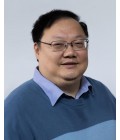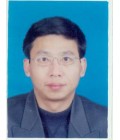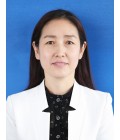熊宇杰,中國科學技術大學教授、博士生導師,1979年出生于江西省吉安市。多年來一直致力于發展無機固體的精準制備化學,應用于催化劑設計和柔性器件制造。2011年在中國科學技術大學工作以來,圍繞固體催化材料體系,致力于發展相關材料表面和界面結構精準可控的合成方法(“無機納米化學”和“無機合成與制備化學”),以合成獲得的具有精準可控結構的材料模型為研究對象,建立表界面結構與催化性能之間的構效關系(“固體結構化學”和“表面與界面化學”),發展決定催化過程中各個步驟的關鍵材料參數設計原則。
教育及工作經歷:
2011年至今,中國科學技術大學,任化學與材料科學學院教授、博導,并雙聘于合肥微尺度物質科學國家實驗室(籌)2009年-2011年,美國華盛頓大學(圣路易斯),任國家納米技術基礎設施組織首席研究員,并兼任納米中心管理主任。
2007年-2009年,美國伊利諾伊大學香檳分校,任材料與科學工程系助理研究員(合作導師:Prof. John A. Rogers)
2004年-2007年,美國華盛頓大學(西雅圖),任化學系博士后(合作導師:Prof. Younan Xia)
2000年-2004年,中國科學技術大學化學系,獲無機化學博士學位(導師:謝毅院士)。
1996年-2000年,中國科學技術大學少年班系00班,獲化學物理學士學位(導師:謝毅院士)。
學術、社會及機構任職:
1、安徽省青年聯合會第十屆委員會委員,2011年至今。
2、歐美同學會千人計劃專家聯誼會化學化工專業委員會委員,2012年至今。
3、中國化學會青年化學工作者委員會委員,2014年至今。
4、第五屆中國青年科技工作者協會會員,2014年至今。
5、Board Committee Member,International Academy of Electrochemical Energy Science (IAOEES),2014年至今。
6、Editorial Board Member,Scientific Reports (Nature Publishing Group),2014年至今。
7、Senior Editor,Journal of Nanoscience Letters (Cognizure),2014年至今。
8、Editorial Board Member,Progress in Natural Science: Materials International (Elsevier),2014年至今。
9、Editorial Board Member,JSM Cell (JSciMed Central),2013年至今。
10、《中國化學快報》青年編委,2014年至今。
11、Journal of the American Chemical Society、Angewandte Chemie、Nature Communications、Chemical Society Reviews、Advanced Materials、Nano Letters、ACS Nano、Advanced Functional Materials、Advanced Energy Materials等60余種國際期刊的審稿人。
培養研究生情況:
目前正在培養碩士和博士研究生22名,已畢業博士生6名、碩士生1名,其中2名研究生獲得研究生最高獎“中國科學院院長特別獎”、8名研究生獲得“研究生國家獎學金”、4名研究生獲得中國科學院“朱李月華獎學金”、1名研究生獲得“牛津儀器明日之星獎學金“、2名研究生獲得“興業全球責任獎學金”、1名研究生獲得“光華獎學金”、2名研究生獲得“中央高校基本科研業務費專項資金”資助。自2011年以來,已指導本科生畢業論文22名和校級“大學生研究計劃”學生12名,其中3個團隊獲得“國家大學生創新訓練計劃項目”資助、1名學生獲中國科學技術大學最高獎“郭沫若獎學金”。
研究方向:
面向全球性的能源與環境方面的重大需求,本課題組在潔凈能源與節能技術方面開展一系列的材料研究工作。主要將納米制造技術與可控合成方法相結合,通過對無機材料性質和功能的調控,在理論上揭示納米結構與產品中的能量傳遞及轉化性能演變規律,在實驗上優化納米結構及器件的結構特征,促進光能、電能、熱能與化學能之間的相互轉換,形成由能量轉換、能量存儲到節能器件的一條龍體系。本課題組的研究屬于交叉學科,涉及化學、材料、物理以及電子等學科領域。
研究總體思路:功能材料的開發及應用發展到目前階段,已遇到一定的瓶頸,關鍵問題在于單一材料體系已然無法突破性能上的限制并滿足應用領域的需求。每種特定的材料都具有某方面獨特的性能及優勢,例如金屬在分子吸附與活化和表面等離子激元方面的特性、半導體在光致電子-空穴分離方面的性質、以及石墨烯等碳材料在二維限域體系中的電子傳輸優勢等。因而材料的復合是突破單一材料性能上瓶頸的有效途徑,并且可以通過協同作用增強各自的性能,比如半導體和金屬復合后有利于降低其電子-空穴復合。然而復合材料的性能通常很難實現材料各自優秀性能的疊加,其中關鍵的瓶頸問題是:1)在實現材料復合的同時,很難做到組成單元各自的表面調控;2)復合材料體系界面的結構調控極為困難。無機材料調控的基礎是化學,因此本課題以無機化學為調控手段,探索功能復合材料體系的表/界面的形成機理、構效關系及調控方法,實現多種材料性能的復合與協同,以優化其在“二氧化碳轉化與分解水制氫”和“柔性無機太陽能電池”兩個應用中的性能。具體到應用體系,光催化和太陽能電池是目前緩解能源與環境危機的兩個重要應用,其原理和過程上有很多的共同點,比如光子的吸收、電子-空穴分離等。本課題組從“以能量轉換為應用導向、以物理機制為理論先導、以無機化學為調控手段”出發,以期實現復合材料的可控生長、合成及構筑,探索材料的構效關系(包括表面和界面結構、成分、尺寸等),確立材料協同工作原理(光電相互作用、電子空穴分離、電子轉移、等離子體激元效應等),力求構筑出具有復合協同功能的材料體系。
1. 面向潔凈能源的納米催化劑設計
二氧化碳轉化燃料的催化反應由于其獨特的可降低大氣中二氧化碳含量并同時產生燃料來源的特點,在未來的能源環境應用領域中將起很重要的作用。近年來,金屬納米催化劑作為二氧化碳光催化轉化反應催化劑(金屬-半導體復合結構)的重要組成部分,已經取得了一些進展,并且證實了其有效性,但是其催化活性與選擇性有待提高。為了進一步開拓金屬納米催化劑在此領域中的應用,課題組提出了通過納米晶的可控合成與新的表征手段來設計與合成高效的二氧化碳光催化轉化燃料的催化劑的構想和實施方案。在此同時,本課題組還將此類納米催化劑的設計與合成方法應用于電催化和有機催化中,以開發其在燃料電池和生物質轉化等潔凈能源中的應用。
2. 高效柔性光電器件的微納制造
傳統的無機光電器件(如太陽能電池和發光二極管等)必須加工成堅硬的板塊狀物件,限制了其許多日常用途。相比之下,柔性器件重量輕、且可以折疊、卷曲、粘貼在曲面上(如汽車玻璃、屋頂、衣服等)。因此業界在致力于提高器件的光電轉換效率的同時,也在不斷努力提高其力學柔性,以使其能夠早日便利地應用到日常生活和高端用途中。目前有機光電器件由于有機分子的獨特韌性,已經較早地應用于柔性器件的設計與加工中。然而,有機光電器件的光電轉換效率等性能遠低于無機光電材料,因此如何克服無機半導體晶片極脆易碎的缺點,是開發出高性能的無機光電器件的關鍵問題之一。本課題組將從無機材料化學的角度,通過結合“自下而上”和“自上而下”兩方面的納米科技方法,在材料的設計合成與微納加工、光電轉換機制與器件設計集成等層次上,對無機半導體的微納化和薄膜化開展系統而深入的研究工作,為其在太陽能轉換和發光器件方面的應用提供新技術。特別的是,本課題組將具有可控表面等離子體激元特性的金屬納米結構集成于器件中,起到增強太陽能電池的光吸收和發光二極管的出光效率等調光作用,以保證半導體材料在納米尺度下的光電性能。
承擔科研項目情況:
1. Infrastructure-Based Joint Grant, National Natural Science Foundation of China (NSFC), Investigation for the Relationship between Surface Structures of Metal Oxides and Performance of Photocatalytic CO2 Conversion Based on Synchrotron Radiation Techniques, 2016-2018
2. Regular Grant, National Natural Science Foundation of China (NSFC), Design and Synthesis of Semiconductor-Metal Hybrid Structures for CO2 Photocatalytic Conversion, 2015-2018
3. National Basic Research Program of China, Ministry of Science and Technology, Coupling and Evolution of Electronic States at the Surface and Interface of Photocatalytic Systems, 2014-2019
4. Specialized Research Fund for the Doctoral Program of Higher Education (for PhD Advisors), Ministry of Education, Inorganic Materials Design for Novel Flexible Solar Conversion Devices, 2013-2015
5. USTC Grant for Key Research Projects, Fundamental Research Funds for the Central Universities, Micro- and Nanostructure Design of Catalysts for Efficient Use of Carbon Resource, 2013-2015
6. Research Innovation Team, Fundamental Research Funds for the Central Universities, Construction and Function Control of Hybrid Nanoscale Systems Based on Low-Dimensional Carbon Materials, 2013-2015
7. Key Research Plan for Nanofabrication, National Natural Science Foundation of China (NSFC), Nanofabrication for High-Efficient, Flexible Thin-Film Monocrystalline Silicon Photovoltaics, 2012-2014
8. Young Investigator Grant, National Natural Science Foundation of China (NSFC), Design, Synthesis and Mechanism Studies of Nanocatalysts for the Conversion of CO2 to Fuels, 2012-2014
9. National Recruitment Program of Global Experts, and Hundred Talent Program, Chinese Academy of Sciences, 2012-2014
10. Young Investigator Grant for Basic Research, Hok Ying Tung Education Foundation, Micro- and Nanostructures in the High-Efficient, Flexible Thin-Film Monocrystalline Silicon Photovoltaics, 2012-2014
11. USTC startup package, University of Science and Technology of China, 2011-2012
12. St. Louis Institute of Nanomedicine (SLIN) Pilot Grant, Missouri Life Sciences Research Board, Correlation of Metallic Nanoparticle Toxicity with Physiochemical Properties, 2010-2011
研究成果:
已在Science、Journal of the American Chemical Society、Angewandte Chemie、Chemical Society Reviews、Advanced Materials等國際刊物上發表論文110余篇,2014年和2015年連續兩年入選Elsevier發布的“中國高被引學者(化學)”榜單。研究論文已被引用10,000余次(H因子為47),其中29篇論文單篇引用過百次,最高單篇引用2,000余次,18篇論文被ESI評為近十年高引頻論文。研究成果被紐約時報、路透社、美國廣播公司、英國廣播公司、美國國家廣播公司、麻省理工技術評論、美國化學與工程新聞、探索頻道、美國新聞與世界報道等國際媒體、網站報道轉載。1項成果入選中國科學院2013年度重大科技基礎設施重要成果。獲得美國專利1項和中國專利4項。
發明專利:
1. A Type of Palladium Nanocrystal and Its Synthesis. Xiong, Y. and Long, R., China Patent Application 201510891010.3
2. Metal Crystalline Nanostructures and Methods for Their Preparation. Xia, Y. and Xiong, Y., US Patent No. 8,257,465
3. Synthesis of alpha-Fe2O3 Catalysts for the Oxidization of Carbon Monoxide. Xie, Y.; Xiong, Y. and Li, Z., China Patent ZL 200410014545.4
4. Aqueous Synthesis of Aligned Ferric Oxyhydroxide Nanowires on Homogenous Substrates. Xie, Y. and Xiong, Y., China Patent ZL 03132256,5
5. Hydrothermal Synthesis of Metal Phosphide Nanowires. Xie, Y.; Xiong, Y. and Li, Z., China Patent ZL 03131771,5
6. Hydrothermal Synthesis of Wurtzite-Type Nitride Nanocrystals and Their Alloy Nanocrystals. Xie, Y. and Xiong, Y., China Patent ZL 03132257.3
Book Chapters:
1. Interactions of Metallic Nanocrystals with Small Molecules. Long, R.; Xiong, Y.,* Metallic Nanostructures: From Controlled Synthesis to Applications (Eds., Xiong, Y.; Lu, X.), Springer (2014).
2. Metallic Nanostructures for Electronics and Optoelectronics. Zhou, S.; Xiong, Y.,* Metallic Nanostructures: From Controlled Synthesis to Applications (Eds., Xiong, Y.; Lu, X.), Springer (2014).
3. Some Recent Development in the Solution-Phase Synthesis of One-Dimensional Inorganic Nanostructures. Xiong, Y.,* One-Dimensional Nanomaterials (Ed., Zhou, Y.), Press of the University of Science and Technology of China (2009).
4. Shape-Controlled Synthesis of Palladium Nanostructures. Xiong, Y. and Xia, Y.*, Functional Nanomaterials: A Chemistry and Engineering Perspective (Eds., Chen, S.; Lin, W.), Press of the University of Science and Technology of China (2008).
5. Application of Coordination Chemistry in the Fabrication of Inorganic Nanostructures . Xie, Y.*; Xiong, Y. and Li, Z., Frontal Nanotechnology Research (Ed., Berg, M. V.), Nova Science Publishers, Inc., Chapter 2, P. 41-59 (2007).
6. Gamma-Irradiation Preparation of Nanomaterials. Xie, Y.* and Xiong, Y., Encyclopedia of Nanoscience and Nanotechnology (Ed., Nalwa, H. S.), American Scientific Publishers, Vol. 3, No. 1, P. 731-748 (2004).
Journal Articles (in chronological order): * Corresponding Author
2016
123. Enhanced Full-Spectrum Water Splitting by Confining Plasmonic Au Nanoparticles in N-doped TiO2 Bowl Nanoarrays. Wang, X.; Long, R.; Liu, D.; Yang, D.; Wang, C. and Xiong, Y.*, Nano Energy DOI: 10.1016/j.nanoen.2016.04.013.
122. Flexible Near-Infrared Photovoltaic Devices Based on Plasmonic Hot Electron Injection into Silicon Nanowire Arrays PDF. Liu, D.; Yang, D.; Gao, Y.; Ma, J.; Long, R.; Wang, C. and Xiong, Y.*, Angew. Chem. Int. Ed. 55, 4577-4581 (2016).
-> Selected as a VIP Paper of Angewandte Chemie.
121. Trimetallic TriStar Nanostructures: Tuning Electronic and Surface Structures for Enhanced Electrocatalytic Hydrogen Evolution PDF. Du, N.; Wang, C.; Wang, X.; Lin, Y.; Jiang, J. and Xiong, Y.*, Adv. Mater. 28, 2077-2084 (2016).
120. Integration of Multiple Plasmonic and Co-catalyst Nanostructures on TiO2 Nanosheets for Visible-near-infrared Photocatalytic Hydrogen Evolution PDF Jiang, W.; Bai, S.;* Wang, L.; Wang, X.; Yang, L.; Li, Y.; Liu, D.; Wang, X.; Li, Z.; Jiang, J. and Xiong, Y.*, Small 12, 1640-1648 (2016).
-> Selected as a 2/2016 Most-Accessed Article of Small.
119. Cooperative Nanoparticle System for Photothermal Tumor Treatment without Skin Damage.Piao, J.; Liu, D.; Hu, K.; Wang, L.; Gao, F.; Xiong, Y.* and Yang, L.*, ACS Appl. Mater. Interf. 8, 2847-2856 (2016).
118. Pd-Ag Alloy Hollow Nanostructures with Interatomic Charge Polarization for Enhanced Electrocatalytic Formic Acid Oxidation PDF. Liu, D.; Xie, M.; Wang, C.;* Liao, L.; Qiu, L.; Ma, J.; Huang, H.; Long, R.; Jiang, J.* and Xiong, Y.*, Nano Res. DOI: 10.1007/s12274-016-1053-6.
117. Incorporation of Pd into Pt Co-catalysts toward Enhanced Photocatalytic Water Splitting PDF.Bai, S.; Xie, M.; Kong, Q.; Jiang, W.; Qiao, R.; Li, Z.;* Jiang, J.* and Xiong, Y.*, Part. Part. Syst. Charact. DOI: 10.1002/ppsc.201500239 (invited research article for the special issue “Energy and Catalysis Research in China”).
116. Atomic Layer Deposition on Pd Nanocrystals for Forming Pd-TiO2 Interface toward Enhanced CO Oxidation. Bai, Y.; Wang, C.; Zhou, X.; Lu, J.* and Xiong, Y.*, Prog. Nat. Sci. Mater. Int. in press (invited research article for the special issue “Nanomaterials and Energy Applications”).
115. Cu/TiO2 Octahedral-Shell Photocatalysts Derived from Metal-Organic Framework @ Semiconductor Hybrid Structures PDF. Li, R.; Wu, S.; Wan, X.; Xu, H.* and Xiong, Y.*, Inorg. Chem. Front. 3, 104-110 (2015) (invited research article for the inaugural “Emerging Investigators” themed collection).
114. Long-term Production of H2 over Pt/CdS Nanoplates under Sunlight Illumination. Feng, J.; An, C.*; Dai, L.; Liu, J.; Wei, G.; Bai, S.; Zhang, J.* and Xiong, Y.*, Chem. Eng. J. 283, 351-357 (2016).
2015
113. Boosting Photocatalytic Water Splitting: Interfacial Charge Polarization in Atomically Controlled Core-shell Co-catalyst PDF. Bai, S.; Yang, L.; Wang, C.; Lin, Y.; Lu, J.; Jiang, J. and Xiong, Y.*, Angew. Chem. Int. Ed. 54, 14810-14814 (2015).
-> Selected as a VIP Paper of Angewandte Chemie.
112. A New Cubic Phase for NaYF4 Host Matrix Offering High Upconversion Luminescence Efficiency PDF. Wang, L.; Li, X.; Li, Z.; Chu, W.; Li, R.; Lin, K.; Qian, H.; Wang, Y.; Wu, C.; Li, J.; Tu, D.; Zhang, Q.; Song, L.; Jiang, J.*; Chen, X.; Luo, Y.; Xie, Y. and Xiong, Y.*, Adv. Mater. 27, 5528-5533 (2015).
111. Palladium-Based Nanomaterials: A Platform to Produce Reactive Oxygen Species for Catalyzing Oxidation PDF.Long, R.; Huang, H.; Li, Y.; Song, L. and Xiong, Y.*, Adv. Mater. 27, 7025-7042 (2015) (invited research progress).
110. Steering Charge Kinetics in Photocatalysis: Intersection of Materials Syntheses, Characterization Techniques and Theoretical Simulations PDF.Bai, S.; Jiang, J.; Zhang, Q. and Xiong, Y.*, Chem. Soc. Rev. 44, 2893-2939 (2015).
-> Featured on the back cover of Chemical Society Reviews.
109. From Bimetallic Metal-Organic Framework to Porous Carbon: High Surface Area and Multicomponent Active Dopants for Excellent Electrocatalysis PDF. Chen, Y. Z.; Wang, C.; Wu, Z. Y.; Xiong, Y.*; Xu, Q.; Yu, S. H. and Jiang, H. L.*, Adv. Mater. 27, 5010-5016 (2015).
108. Toward Enhanced Photocatalytic Oxygen Evolution: Synergetic Utilization of Plasmonic Effect and Schottky Junction via Interfacing Facet Selection PDF. Bai, S.; Li, X.; Kong, Q.; Long, R.; Wang, C.; Jiang, J. and Xiong, Y.*, Adv. Mater. 27, 3444-3452 (2015).
107. Novel Pt Multicubes Prepared by Ni2+-mediated Shape Evolution Exhibit High Electrocatalytic Activity for Oxygen Reduction PDF. Ma, L.; Wang, C.; Xia, B. Y.; Mao, K.; He, J.; Wu, X.; Xiong, Y.* and Lou, X. W.*, Angew. Chem. Int. Ed. 54, 5666-5671 (2015).
106. The Nature of Photocatalytic “Water Splitting” on Silicon Nanowires PDF. Liu, D.; Li, L.; Gao, Y.; Wang, C.; Jiang, J. and Xiong, Y.*, Angew. Chem. Int. Ed. 54, 2980-2985 (2015).
-> Selected as a Hot Paper of Angewandte Chemie.
105. Efficiently Coupling Solar Energy into Catalytic Hydrogenation by Well-Designed Pd Nanostructures PDF. Long, R.; Rao, Z.; Mao, K.; Li, Y.; Zhang, C.; Liu, Q.; Wang, C.; Li, Z. Y.; Wu, X. and Xiong, Y.*, Angew. Chem. Int. Ed. 54, 2425-2430 (2015).
104. Some Recent Developments in Surface and Interface Design for Photocatalytic and Electrocatalytic Hybrid Structures PDF.Bai, S. and Xiong, Y.*, Chem. Commun. 51, 10261-10271 (2015) (invited feature article).
103. Surface and Interface Engineering in Photocatalysis PDF. Bai, S.; Jiang, W.; Li, Z. and Xiong, Y.*, ChemNanoMat 1, 223-239 (2015) (invited review article).
102. Coupling Solar Energy into Reactions: Materials Design for Surface Plasmon-Mediated Catalysis PDF. Long, R.; Li, Y.; Song, L. and Xiong, Y.*, Small 11, 3873-3889 (2015) (invited review article).
101. Towards Full-spectrum Photocatalysis: Achieving Z Scheme between Ag2S and TiO2 by Engineering Energy Band Alignment with Interfacial Ag PDF. Li, Y.; Li, L.; Gong, Y.; Bai, S.; Ju, H.; Wang, C.; Xu, Q.; Zhu, J.; Jiang, J.* and Xiong, Y.*, Nano Res. 8, 3621-3629 (2015).
100. Etching Approach to Hybrid Structures between PtPd Nanocages and Graphene towards Efficient Oxygen Reduction Reaction PDF.Bai, S.; Wang, C.*; Jiang, W.; Du, N.; Li, J.; Du, J.; Long, R.; Li, Z. and Xiong, Y.*, Nano Res. 8, 2789-2799 (2015).
99. Enhancing the Catalytic Efficiency of the Heck Coupling Reaction by Forming 5 nm Pd Octahedrons Using Kinetic Control PDF. Long, R.; Wu, D.; Li, Y.; Bai, Y.; Wang, C.; Song, L. and Xiong, Y.*, Nano Res. 8, 2115-2123 (2015).
98. Chemically Exfoliated Metallic MoS2 Nanosheets: A Promising Supporting Co-catalyst for Enhancing Photocatalytic Performance of TiO2 Nanocrystals PDF. Bai, S.; Wang, L.; Chen, X.; Du, J. and Xiong, Y.*, Nano Res. 8, 175-183 (2015).
-> Selected as an ESI Highly Cited Paper.
97. Pd-Ag Alloy Nanocages: Integration of Ag Plasmonic Properties with Pd Active Sites for Light-Driven Catalytic Hydrogenation PDF.Zhao, X.; Long, R.; Liu, D.; Luo, B. and Xiong, Y.*, J. Mater. Chem. A 3, 9390-9394 (2015).
96. Composition-Dependent Activity of Cu-Pt Alloy Nanocubes for Electrocatalytic CO2 Reduction PDF.Zhao, X.; Luo, B.; Long, R.; Wang, C. and Xiong, Y.*, J. Mater. Chem. A 3, 4134-4138 (2015).
95. Precise Control over the Surface and Interface Structures of Nanocatalysts PDF. Bai, S. and Xiong, Y.*, Sci. Adv. Today 1, 25215 (2015) (invited review article for 2015 Nanoscience Research Leader Award).
94. Recent Advances in Surface and Interface Engineering for Electrocatalysis PDF. Wang, C.*; Bai, S. and Xiong, Y.*, Chin. J. Catal. 36, 1476-1493 (2015) (invited review article for 2013 Young Chemist Award by the Chinese Chemical Society).
93. Recent Advances in Two-Dimensional Nanostructures for Catalysis Applications.Bai, S. and Xiong, Y.*, Sci. Adv. Mater. 7, 2168-2181 (2015) (invited review article).
-> Selected as an ESI Hot Paper.
92. Stable Metallic 1T-WS2 Nanoribbons Intercalated with Ammonia Ions: The correlation between Structure and Electrical/Optical Properties. Liu, Q.; Li, X.; Xiao, Z.; Zhou, Y.; Chen, H.; Xiang, T.; Xu, J.; Chu, W.; Wu, X.;* Yang, J.; Wang, C.; Xiong, Y.; Jin, C.; Ajayan, P. M. and Song, L.*, Adv. Mater. 27, 4837-4844 (2015).
91. Large-area Synthesis of Monolayer WSe2 on SiO2/Si Substrate and its Device Applications. Huang, J.; Yang, L.; Liu, D.; Chen, J.; Fu, Q.; Xiong, Y.; Lin, F. and Xiang, B.*, Nanoscale 7, 4193-4198 (2015).
2014
90. Controllably Interfacing with Metal: A Strategy for Enhancing CO Oxidation on Oxide Catalysts by Surface Polarization PDF.Bai, Y.; Zhang, W.; Zhang, Z.; Zhou, J.; Wang, X.; Wang, C.; Huang, W.*; Jiang, J.* and Xiong, Y.*, J. Am. Chem. Soc. 136, 14650-14653 (2014).
89. Surface Polarization Matters: Enhancing the Hydrogen Evolution Reaction by Shrinking Pt Shells in Pt-Pd-Graphene Stack Structures PDF. Bai, S.; Wang, C.; Deng, M.; Gong, M.; Bai, Y.; Jiang, J. and Xiong, Y.*, Angew. Chem. Int. Ed. 53, 12120-12124 (2014).
-> Featured on the back cover of Angewandte Chemie.
88. Oxidative Etching for Controlled Synthesis of Metal Nanocrystals: Atomic Addition and Subtraction PDF. Long, R.; Zhou, S.; Wiley, B. J.* and Xiong, Y.*, Chem. Soc. Rev. 43, 6288-6310 (2014).
-> Featured on the inside front cover of Chemical Society Reviews.
87. Designing p-Type Semiconductor-Metal Hybrid Structures for Improved Photocatalysis PDF. Wang, L.; Ge, J.; Wang, A.; Deng, M.; Wang, X.; Bai, S.; Li, R.; Jiang, J.;* Zhang, Q.;* Luo, Y. and Xiong, Y.*, Angew. Chem. Int. Ed. 53, 5107-5111 (2014).
86. Tunable Oxygen Activation for Catalytic Organic Oxidation: Schottky Junction versus Plasmonic Effect PDF .Long, R.; Mao, K.; Gong, M.; Zhou, S.; Hu, J.; Zhi, M.; You, Y.; Bai, S.; Jiang, J.; Zhang, Q.;* Wu, X.* and Xiong, Y.*, Angew. Chem. Int. Ed. 53, 3205-3209 (2014).
85. A Unique Semiconductor-Metal-Graphene Stack Design to Harness Charge Flow for Photocatalysis PDF. Bai, S.; Ge, J.; Wang, L.; Gong, M.; Deng, M.; Kong, Q.; Song, L.; Jiang, J.;* Zhang, Q.;* Luo, Y.; Xie, Y. and Xiong, Y.*, Adv. Mater. 26, 5689-5695 (2014).
-> Featured on the inside front cover of Advanced Materials.
84. Integration of Inorganic Semiconductor with MOF: A Platform for Enhanced Gaseous Photocatalytic Reactions PDF. Li, R.; Hu, J.; Deng, M.; Wang, H.; Wang, X.; Hu, Y.; Jiang, H. L.; Jiang, J.;* Zhang, Q.;* Xie, Y. and Xiong, Y.*, Adv. Mater. 26, 4783-4788 (2014).
-> Featured on the inside back cover of Advanced Materials.
83. Erythrocyte Membrane Is an Alternative Coating to Polyethylene Glycol for Prolonging the Circulation Lifetime of Gold Nanocages for Photothermal Therapy PDF.Piao, J. G.; Wang, L.; Gao, F.; You, Y. Z.*; Xiong, Y.* and Yang, L.*, ACS Nano 8, 10414-10425 (2014).
82. Two-Dimensional g-C3N4: An Ideal Platform for Examining Facet Selectivity of Metal Co-Catalysts in Photocatalysis PDF. Bai, S.; Wang, X.; Hu, C.; Xie, M.; Jiang, J.* and Xiong, Y.*, Chem. Commun. 50, 6094-6097 (2014).
-> Featured on the inside front cover of Chemical Communications.
81. Self-assembly of LaF3:Yb,Er/Tm Nanoplates into Colloidal Spheres and Tailoring Their Upconversion Emissions with Fluorescent Dyes. Bao, L.; You, H.; Wang, L.; Li, L.; Qiao, R.; Zhang, Y.; Zhong, Y.; Xiong, Y. and Li, Z.*, J. Mater. Chem. C 2, 8949-8955 (2014).
80. Solvothermal Synthesis of Ternary Cu2MoS4 Nanosheets: Structural Characterization at the Atomic Level
Chen, W.; Chen, H.; Zhu, H.; Gao, Q.; Luo, J.; Wang, Y.; Zhang, S.; Zhang, K.; Wang, C.; Xiong, Y.; Wu, Y.; Zheng, X.; Chu, W.; Song, L.* and Wu, Z.*, Small 10, 4637-4644 (2014).
2013
79. Surface Facet of Palladium Nanocrystals: a Key Parameter to the Activation of Molecular Oxygen for Organic Catalysis and Cancer Treatment PDF . Long, R.; Mao, K.; Ye, X.; Yan, W.; Huang, Y.; Wang, J.; Fu, Y.; Wang, X.; Wu, X.; Xie, Y. and Xiong, Y.*, J. Am. Chem. Soc. 135, 3200-3207 (2013).
-> Highlighted by the Chemical & Engineering News (CEN) on February 25, 2013.
78. A Unique Platinum-Graphene Hybrid Structure for High Activity and Durability in Oxygen Reduction Reaction PDF Wang, C.; Ma, L.; Liao, L.; Bai, S.; Long, R.; Zuo, M. and Xiong, Y.*, Sci. Rep. 3, 2580 (2013); DOI: 10.1038/srep02580.
77. Activation of Specific Sites on Cubic Nanocrystals: A New Pathway for Controlled Epitaxial Growth towards Catalytic Applications PDF .Bai, Y.; Long, R.; Wang, C.; Gong, M.; Li, Y.; Huang, H.; Xu, H.; Li, Z.; Deng, M. and Xiong, Y.*, J. Mater. Chem. A 1, 4228-4235 (2013).
-> Featured on the back cover of J. Mater. Chem. A.
76. The Role of Surface Chemistry on the Toxicity of Ag Nanoparticles PDF . Xiong, Y.;* Brunson, M.; Huh, J.; Huang, A.; Coster, A.; Wendt, K.; Fay, J. and Qin, D.*, Small 9, 2628-2638 (2013).
-> Selected as "Hot Topics: Surfaces and Interfaces" by Wiley-VCH.
75. Synthesis of Rhombic Hierarchical YF3 Nanocrystals and Their Use as Upconversion Photocatalysts after TiO2 Coating. Li, Z.;* Li, C.; Mei, Y.; Wang, L.; Du, G. and Xiong, Y.*, Nanoscale 5, 3030-3036 (2013).
74. Controlled Synthesis of Uniform LaF3 Polyhedrons, Nanorods and Nanoplates Using NaOH and Ligands. Bao, L.; Li, Z.;* Tao, Q.; Xie, J.; Mei, Y. and Xiong, Y.*, Nanotechnology 24, 145604 (2013).
73. Shape-Controlled Synthesis of Pd Nanocrystals and Their Catalytic Applications. Zhang, H.; Jin, M.; Xiong, Y.; Lim, B. and Xia, Y.*, Acc. Chem. Res. 46, 1783-1794 (2013).
2012
72. Control Over the Branched Structures of Platinum Nanocrystals for Electrocatalytic Applications PDF .Ma, L.; Wang, C.; Gong, M.; Liao, L.; Long, R.; Wang, J.; Wu, D.; Zhong, W.; Kim, M.;* Chen, Y.; Xie, Y. and Xiong, Y.*, ACS Nano 6, 9797-9806 (2012).
71. Investigation of Size-Dependent Plasmonic and Catalytic Properties of Metallic Nanocrystals Enabled by Size Control with HCl Oxidative Etching PDF.Li, B.; Long, L.; Zhong, X.; Bai, Y.; Zhu, Z.; Zhang, X.; Zhi, M.; He, J.; Wang, C.; Li, Z.-Y. and Xiong, Y.*, Small 8, 1710-1716 (2012).
70. Solar Energy Conversion with Tunable Plasmonic Nanostructures for Thermoelectric Devices PDF.Xiong, Y.*; Long, R.; Liu, D.; Zhong, X.; Wang, C.; Li, Z.-Y. and Xie, Y., Nanoscale 4, 4416-4420 (2012).
-> Featured on the inside front cover of Nanoscale.
69. Anisotropic Growth of Palladium Twinned Nanostructures Controlled by Kinetics and Their Unusual Activities in Galvanic Replacement PDF. Wang, C.; Wang, L.; Long, L.; Ma, L.; Wang, L.; Li, Z.* and Xiong, Y.*, J. Mater. Chem. 22, 8195-8198 (2012).
68. Identifying Structural Distortion in Doping VO2 with IR Spectroscopy. Long, R.; Qu, B.; Tan, R.; Sun, Y.; Tan, X.; Ying, W.; Pan, B.; Xiong, Y.* and Xie, Y.*, Phys. Chem. Chem. Phys. 14, 7225-7228 (2012).
67. Controlled Synthesis of Gd2(WO4)3 Microstructures and Their Tunable Photoluminescent Properties after Eu3+/Tb3+ Doping. Zeng, Y.; Li, Z.;* Wang, L. and Xiong, Y.*, Cryst. Eng. Comm. 14, 7043-7048 (2012).
66. Facile Synthesis of GdBO3 Spindle Assemblies and Microdisks as Versatile Host Matrixes for Lanthanides Doping. Li, Z.;* Zeng, Y.; Qian, H.; Long, R. and Xiong, Y.*, Cryst. Eng. Comm. 14, 3959-3964 (2012).
2011
65. Morphological Changes in Ag Nanocrystals Triggered by Citrate Photoreduction and Governed by Oxidative Etching PDF. Xiong, Y.* Chem. Commun. 47, 1580-1582 (2011).
64. Modification of NaYF4:Yb,Er@SiO2 Core-shell Nanoparticles with Gold Nanocrystals for Tunable Green-to-red Upconversion Emissions. Li, Z.;* Wang, L.; Wang, Z.; Liu, X. and Xiong, Y.*, J. Phys. Chem. C 115, 3291-3296 (2011).
2009
63. Printed Assemblies of Inorganic Light-Emitting Diodes for Deformable and Semitransparent Displays PDF.Park, S.-I.; Xiong, Y. (Equal Contribution); Kim, R.-H.; Elvikis, P.; Meitl, M.; Kim, D.-H.; Wu, J.; Yoon, J.; Yu, C.-J.; Liu, Z.; Huang, Y.; Hwang, K.-C.; Ferreira, P.; Li, X.; Choquette K.; and Rogers, J.A.*, Science 325, 977-981 (2009).
-> Highlighted in ScienceNOW, 20 August 2009.
-> Highlighted in Chemical & Engineering News (C&EN), 24 August 2009.
-> Reported by The New York Times, ABC, BBC News, NBC, Reuters, US News and World Report, Discovery Channel, Discover Magazine, MIT Technology Review, Science Daily, Scientific American, Yahoo, CNet, Daily Tech, IT PRO, Nanowerk, newKerala, NewsFactor, NewsGuide.us, PhysOrg, R&D Magazine, ECNmag.com, Chemie.de, Daily India, Innovations Report, IT Web, Malaysia Sun, PC Magazine, Science Centric, The Engineer, Zimbabwe Star, Buenos Aires Herald, Herald de Paris, Infoworld, The Boston Globe, The Times of India, WNDU TV, Mother Nature Network, HDTV News, Rapid Electronics, IEEE Spectrum, Physics World, Live Science, Tech World, Sci-Tech Today, Photonics.com, PC World, Newsfactor.com, Nature, Optics and Photonics Focus, Inside Illinois.
62. Shape-Controlled Synthesis of Metal Nanocrystals: Simple Chemistry Meets Complex Physics? PDF. Xia, Y.;* Xiong, Y.; Lim, B. and Skrabalak, S. E., Angew. Chem. Int. Ed. 48, 60-103 (2009).
-> Featured on the front cover of Angewandte Chemie.
-> Selected as the Most-Cited Paper by Thomson Reuters Essential Science Indicators, and featured
as a Fast Moving Front Paper on Science Watch.
-> Featured on the Wiley-VCH website as a 12/2008 Most-Accessed Article of Angewandte Chemie.
-> Featured on the Wiley-VCH website as a 11/2008-10/2009 Most-Accessed Article of Angewandte Chemie.
61. Omnidirectional Printing of Flexible, Spanning, and Stretchable Silver Microelectrodes. Ahn, B. Y.; Duoss, E. B.; Motala, M. J.; Guo, X.; Park, S. I.; Xiong, Y.; Yoon, J.; Nuzzo, R. G.; Rogers, J. A.; and Lewis, J. A.*, Science 323, 1590-1593 (2009).
-> Highlighted in Science Perspectives, 20 March 2009.
-> Highlighted in Nature Materials, April 2009.
-> Highlighted in Science Daily, MIT Technology Review, MarketWatch, Product Design & Development, Science Centric, AZOmaterials, e! Science News, Nanotechnology Now, PhysOrg, The Post Chronicle, redOrbit, The Money Times, UPI.com, insciences.org, Times of the Internet.
2008
60. Adding new functions to organic semiconductor nanowires by assembling metal nanoparticles onto their surfaces.Briseno, A. L.; Mannsfeld, S. C. B.; Formo, E.; Xiong, Y.; Lu, X.; Bao, Z.; Jenekhe, S. A. and Xia, Y.*, J. Mater. Chem. 18, 5395-5398 (2008).
59. Cubic to Tetragonal Phase Transformation in Cold-Compressed Pd Nanocubes.Guo, Q.*; Zhao, Y.; Mao, W. L.; Wang, Z.; Xiong, Y. and Xia, Y., Nano Lett. 8, 972-975 (2008).
58. Polymer Induced Generation of Anatase TiO2 Hollow Nanostructures. Li, X.; Xiong, Y.; Zou, L.; Wang, M. and Xie, Y.*, Microporous Mesoporous Mater. 112, 641-646 (2008).
2007
57. Synthesis and Mechanistic Study of Palladium Nanobars and Nanorods PDF
Xiong, Y.; Cai, H.; Wiley, B. J.; Wang, J.; Kim, M. and Xia, Y.*, J. Am. Chem. Soc. 127, 3665-3675 (2007).
-> Featured on the ACS website as one of the Most-Cited Articles published in JACS in 2007.
56. Trimeric Clusters of Silver in AgNO3 Aqueous Solutions and Their Role as Nuclei in Forming Triangular Nanoplates of Silver PDF.Xiong, Y.; Washio, I.; Chen, J.; Sadilek, M. and Xia, Y.*, Angew. Chem. Int. Ed. 46, 4917-4921 (2007).
55. Synthesis of Palladium Icosahedra with a Twinned Structure by Blocking Oxidative Etching with Citric Acid or Citrate Ion PDF.Xiong, Y.; McLellan, J. M.; Yin, Y. and Xia, Y.*, Angew. Chem. Int. Ed. 46, 790-794 (2007).
-> Selected as an Angewandte Chemie VIP Paper.
-> Featured on the inside cover of Angewandte Chemie.
54. Nanocrystals with Unconventional Shapes -- A Class of Promising Catalysts PDF.Xiong, Y.; Wiley, B. J. and Xia, Y.*, Angew. Chem. Int. Ed. 46, 7157-7159 (2007).
53. Shape-Controlled Synthesis of Metal Nanostructures: The Case of Palladium PDF. Xiong, Y. and Xia, Y.*, Adv. Mater. 19, 3385-3391 (2007).
-> Selected as a 10/2007 most access article of Advanced Materials.
52. Synthesis of Silver Nanoplates at High Yields by Slowing Down the Polyol Reduction of Silver Nitrate with Polyacrylamide.Xiong, Y. (Equal Contribution); Siekkinen, A. R.; Wang, J.; Yin, Y.; Kim, M. J. and Xia, Y.*, J. Mater. Chem. 17, 2600-2602 (2007).
-> Featured on the front cover of Journal of Materials Chemistry.
51. Synthesis and Characterization of Fivefold Twinned Nanorods and Right Bipyramids of Palladium. Xiong, Y.; Cai, H.; Yin, Y. and Xia, Y.*, Chem. Phys. Lett. 440, 273-278 (2007).
50. Facile Synthesis of Tadpole-Like Nanostructures Consisting of Au Heads and Pd Tails.Camargo, P. H. C.; Xiong, Y.; Ji, L.; Zuo, J. M. and Xia, Y.*, J. Am. Chem. Soc. 127, 15452-15453 (2007).
49. Water-Based Synthesis of Pd Nanocrystals with an Octahedral, Decahedral, or Icosahedral Shape. Lim, B.; Xiong, Y. and Xia, Y.*, Angew. Chem. Int. Ed. 46, 9279-9282 (2007).
48. Perylenediimide Nanowires and Their Use in Fabricating Field-Effect Transistors and Complementary Inverters.Briseno, A. L.; Mannsfeld, S. C. B.; Reese, C.; Hancock, J. M.; Xiong, Y.; Jenekhe, S. A.; Bao, Z. and Xia, Y.*, Nano Lett. 7, 2847-2853 (2007).
-> Highlighted in EE Times in October 2007.
47. Synthesis and Optical Properties of Silver Nanobars
Wiley, B. J.; Chen, Y.; McLellan, J.; Xiong, Y.; Li, Z.-Y.; Ginger, D. S. and Xia, Y.*, Nano Lett. 7, 1032-1036 (2007).
-> Highlighted in Photonics Spectra, 2007, May, p. 84.
-> Featured on the ACS website as a 2007 Most-Access Article of Nano Letters.
46. Fabrication of Field-Effect Transistors from Hexathiapentacene Single-Crystal Nanowires.Briseno, A. L.; Mannsfeld, S. C. B.; Lu, X.; Xiong, Y.; Jenekhe, S. A.; Bao, Z. and Xia, Y.*, Nano Lett. 7, 668-675 (2007).
-> Highlighted in Nano Today 2, 9 (2007).
2006
45. Poly(vinyl pyrrolidone): A Dual Functional Reductant and Stabilizer for the Facile Synthesis of Metal Nanoplates in Aqueous Solutions.Xiong, Y.; Washio, I.; Chen, J.; Cai, H.; Li, Z.-Y. and Xia, Y.*, Langmuir 22, 8563-8570 (2006).
-> Selected as a July-September 2006 most access article of Langmuir.
44. Facile Synthesis of Gold-Silver Nanocages with Controllable Pores on the Surface .Chen, J.; McLellan, J. M.; Siekkinen, A.; Xiong, Y.; Li, Z.-Y. and Xia, Y.*, J. Am. Chem. Soc. 128, 14776-14777 (2006).
-> Selected as an October-December 2006 most access article of Journal of the American Chemical Society.
43. Surfactant-Directed Assembly of Pt Nanoparticles into Colloidal Spheres and Their Use as Substrates in Forming Pt Nanorods and Nanowires.Chen, J.; Xiong, Y.; Yin, Y. and Xia, Y.*, Small 2, 1340-1343 (2006).
->Selected as a 5/2006-4/2007 most access article of Small.
42. Reduction by the End Groups of Poly(vinyl pyrrolidone): A New and Versatile Route to the Kinetically Controlled Synthesis of Ag Triangular Nanoplates .Washio, I.; Xiong, Y.; Yin, Y. and Xia, Y.*, Adv. Mater. 18, 1745-1749 (2006).
41. Right Bipyramids of Silver: A New Shape Derived from Single Twinned Seeds.Wiley, B. J.; Xiong, Y.; Li, Z.-Y.; Yin, Y. and Xia, Y.*, Nano Lett. 6, 765-768 (2006).
40. Surface-Enhanced Raman Scattering of 4-Mercaptopyridine on Thin Films of Nanoscale Pd Cubes, Boxes, and Cages.McLellan, J. M.; Xiong, Y.; Hu, M. and Xia, Y.*, Chem. Phys. Lett. 417, 230-234 (2006).
39. Large-Scale Fabrication of TiO2 Hierarchical Hollow Spheres. Li, X.; Xiong, Y.; Li, Z. and Xie, Y.*, Inorg. Chem. 45, 3493-3495 (2006).
-> Selected as an April-June 2006 most access article of Inorganic Chemistry.
38. Solution-Phase Template Approach for the Synthesis of Cu2S Nanoribbons. Li, Z.; Yang, H.; Ding, Y.; Xiong, Y. and Xie, Y.*, Dalton Trans. 149-151 (2006).
2005
37. Kinetically Controlled Synthesis of Triangular and Hexagonal Nanoplates of Pd and Their SPR/SERS Properties PDF.Xiong, Y.; McLellan, J. M.; Chen, J.; Yin, Y.; Li, Z.-Y. and Xia, Y.*, J. Am. Chem. Soc. 127, 17118-17127 (2005).
36. Understanding the Role of Oxidative Etching in the Polyol Synthesis of Pd Nanoparticles with Uniform Shape and Size PDF.Xiong, Y.; Chen, J.; Wiley, B.; Xia, Y.*; Aloni, S. and Yin, Y., J. Am. Chem. Soc. 127, 7332-7333 (2005).
35. Corrosion-Based Synthesis of Single-Crystal Pd Nanoboxes and Nanocages and Their Surface Plasmon Properties PDF.Xiong, Y.; Wiley, B.; Chen, J.; Li, Z.-Y.; Yin, Y. and Xia, Y.*, Angew. Chem. Int. Ed. 44, 7913-7917 (2005).
-> Selected as a Hot Paper of Angewandte Chemie.
34. Size-Dependence of Surface Plasmon Resonance and Oxidation for Pd Nanocubes Synthesized via a Seed Etching Process PDF.Xiong, Y.; Chen, J.; Wiley, B.; Xia, Y.*; Yin, Y. and Li, Z.-Y., Nano Lett. 5, 1237-1242 (2005).
33. Some Recent Developments in the Chemical Synthesis of Inorganic Nanotubes
Xiong, Y.; Mayers, B. T. and Xia, Y.*, Chem. Commun. 5013-5022 (2005).
32. Synthesis of Smooth and Bamboo-like Well-Crystalline CNx Nanotubes with Controllable Nitrogen Concentration (x = 0.05-1.02).Xiong, Y.; Li, Z.; Quo, Q. and Xie, Y.*, Inorg. Chem. 44, 6506-6508 (2005).
31. Optical Properties of Pd-Ag and Pt-Ag Nanoboxes Synthesized via Galvanic Replacement Reactions. Chen, J.; Wiley, B.; McLellan, J. M.; Xiong, Y.; Li, Z.-Y. and Xia, Y.*, Nano Lett. 5, 2058-2062 (2005).
-> Selected as an October-December 2005 most access article of Nano Letters.
30. Selective Growth of ZnO Nanostructures with Coordination Polymers .Li, Z.; Xiong, Y. and Xie, Y.*, Nanotechnology 16, 2303-2308 (2005).
29. Rational Growth of Various alpha-MnO2 Hierarchical Structures and beta-MnO2 Nanorods via Homogenous Catalytic Route. Li, Z.; Ding, Y.; Xiong, Y. and Xie, Y.*, Crys. Growth Degn. 5, 1953-1958 (2005).
28. One-Step Solution-Based Catalytic Route to Fabricate Novel alpha-MnO2 Hierarchical Structures on a Large Scale.Li, Z.; Ding, Y.; Xiong, Y.; Yang, Q. and Xie, Y.*, Chem. Comm. 918-920 (2005).
2004
27. Aqueous-Solution Growth of GaP and InP Nanowires: A General Route to Phosphide, Oxide, Sulfide and Tungstate Nanowires.Xiong, Y.; Xie, Y.*; Li, Z.; Li, X. and Gao, S., Chem. Eur. J. 10, 654-660 (2004).
26. Thermally Stable Hematite Hollow Nanowires Xiong, Y.; Li, Z.; Li, X.; Hu, B. and Xie, Y.*, Inorg. Chem. 43, 6540-6542 (2004).
25. Production of Novel Amorphous Carbon Nanostructures from Ferrocene in Low-Temperature Solution.Xiong, Y.; Xie, Y.*; Li, X. and Li, Z., Carbon 42, 1447-1453 (2004).
24. Aqueous Synthesis of Group IIIA Nitrides at Low Temperature .Xiong, Y.; Xie, Y.*; Li, Z.; Li, X. and Zhang, R., New J. Chem. 28, 214-217 (2004).
23. Room-Temperature Surface-Erosion Route to ZnO Nanorod Arrays and Urchin-like Assemblies. Li, Z.; Ding, Y.; Xiong, Y.; Yang, Q. and Xie, Y.*, Chem. Eur. J. 10, 5823-5828 (2004).
22. Structure-Direct Assembling of Hexagonal Pencil-Like ZnO Group Whiskers. Hou, H.; Xiong, Y.; Xie, Y.*; Li, Q.; Zhang, J. and Tian, X., J. Solid State Chem. 177, 176-180 (2004).
2003
21. Fabrication of Self-Supported Patterns of Aligned beta-FeOOH Nanowires via a Low-Temperature Solution Reaction.Xiong, Y.; Xie, Y.*; Chen, S. and Li, Z., Chem. Eur. J. 9, 4991-4996 (2003).
20. Formation of Silver Nanowires Through a Sandwich Reduction Process.Xiong, Y.; Xie, Y.*; Wu, C.; Yang, J.; Li, Z. and Xu, F., Adv. Mater. 15, 405-408 (2003).
19. Growth of Well-Aligned gamma-MnO2 Monocrystalline Nanowires through a Coordination-Polymer-Precursor Route.Xiong, Y.; Xie, Y.*; Li, Z. and Wu, C., Chem. Eur. J. 9, 1645-1651 (2003).
18. From Complex Chains to 1D Metal Oxides: A Novel Strategy to Cu2O Nanowires.Xiong, Y.; Li, Z.; Zhang, R.; Xie, Y.*; Yang, J. and Wu, C., J. Phys. Chem. B 107, 3697-3702 (2003).
17. A Novel Approach to Carbon Hollow Spheres and Vessels from CCl4 at Low Temperatures.Xiong, Y.; Xie, Y.*; Li, Z.; Wu, C. and Zhang, R., Chem. Commun. 904-905 (2003).
-> Selected as a TOP 10 hot paper of Chemical Communications.
16. Complexing-Reagent Assisted Synthesis of alpha-Fe and gamma-Fe2O3 Nanowires under Mild Conditions .Xiong, Y.; Xie, Y.*; Li, Z.; Zhang, R.; Yang, J. and Wu, C., New J. Chem. 27, 588-590 (2003).
15. Micelle-Assisted Fabrication of Necklace-Shaped Assembly of Inorganic Fullerene-like Molybdenum Disulfide Nanospheres.Xiong, Y.; Xie, Y.*; Li, Z.; Li, X. and Zhang, R., Chem. Phys. Lett. 382, 180-185 (2003).
14. Selected-Control Synthesis of ZnO Nanowires and Nanorods via a PEG-assisted Route.Li, Z.; Xiong, Y. and Xie, Y.*, Inorg. Chem. 42, 8105-8109 (2003).
13. A Novel Non-Template Solution Approach to Fabricate ZnO Hollow Spheres with a Coordination Polymer as a Reactant.Li, Z.; Xie, Y.*; Xiong, Y. and Zhang, R., New J .Chem. 27, 1518-1521 (2003).
12. Reverse Micelle-Assisted Route to Control Diameters of ZnO Nanorods by Selecting Different Precursors.Li, Z.; Xie, Y.*; Xiong, Y.; Zhang, R. and He, W., Chem. Lett. 32, 760-761 (2003).
2002
11. From 2D Framework to Quasi-1D Nanomaterial: Preparation, Characterization and Formation Mechanism of Cu3SnS4 Nanorods.Xiong, Y.; Xie, Y.*; Du, G. and Su, H., Inorg. Chem. 41, 2953-2959 (2002).
10. In situ Micelle-Template-Interface Reaction Route to CdS Nanotubes and Nanowires.Xiong, Y.; Xie, Y.*; Yang, J.; Zhang, R.; Wu, C. and Du, G., J. Mater. Chem. 12, 3712-3716 (2002).
-> Selected as a TOP 10 most accessed article of Journal of Materials Chemistry.
9. A Solvent-Reduction and Surface-Modification Technique to Morphology Control of Tetragonal In2S3 Nanocrystals.Xiong, Y.; Xie, Y.*; Du, G. and Tian, X., J. Mater. Chem. 12, 98-102 (2002).
8. Ultrasound-Assisted Self-Regulation Route to Ag Nanorods.Xiong, Y.; Xie, Y.*; Du, G.; Liu, X. and Tian, X., Chem. Lett. 98-99 (2002).
7. A Novel in Situ Oxidization-Sulfidation Growth Route via A Self-Purification Process to beta-In2S3 Dendrites.Xiong, Y.; Xie, Y.*; Du, G.; Tian, X. and Qian, Y., J. Solid State Chem. 166, 336-340 (2002).
6. Synthesis of Rod-, Twinrod-, and Tetrapod-Shaped CdS Nanocrystals Using a Highly Oriented Solvothermal Recrystallization Technique. Chen, M.; Xie, Y.*; Lu, J.; Xiong, Y.; Zhang, S.; Qian, Y. and Liu, X., J. Mater. Chem. 12, 748-753 (2002).
2000-2001
5. Sonochemical Coreduction Route to Single-Crystalline InSb Dendrites.Xiong, Y.; Xie, Y.*; Du, G.; Liu, X. and Tian, X., Chem. Lett. 1038-1039 (2001).
4. A Mild Solvothermal Route to Chalcopyrite Quaternary Semiconductor CuIn(SexS1-x)2 Nanocrystallites. Xiao, J.; Xie, Y.*; Xiong, Y.; Tang, R. and Qian, Y., J. Mater. Chem. 11, 1417-1420 (2001).
3. Synthesis of MS/TiO2 (M=Pb,Zn,Cd) Nanocomposites through a Mild Sol-Gel Process. Su, H.; Xie, Y.*; Gao, P.; Xiong, Y. and Qian, Y., J. Mater. Chem. 11, 684-686 (2001).
2. Preparation and Morphology Control of Rod-like Nanocrystalline Tin Sulfides via a Simple Ethanol Thermal Route.Su, H.; Xie, Y.*; Xiong, Y.; Gao, P. and Qian, Y., J. Solid State Chem. 161, 190-196 (2001).
1. Synthesis and Formation Mechanism of Bi(Se,S) Nanowires via a Solvothermal Template Process. Su, H.; Xie, Y.*; Gao, P.; Lu, H.; Xiong, Y. and Qian, Y., Chem. Lett. 790-791 (2000).
中文論文:
5. 一步法合成的Pd凹面立方體及其電催化甲酸氧化性質研究.饒州鋁, 龍冉,* 熊宇杰,* 中國科學技術大學學報 (正在出版).
4. 以催化功能優化為導向的無機復合結構表界面和電子態調控.龍冉, 李睿, 熊宇杰,* 化學通報78, 580-589 (2015) (2013年度中國化學會青年化學獎邀請綜述).
3. 金屬納米結構的氧化刻蝕調控與催化性能優化.王成名,* 鐘瑋, 廖玲文, 熊宇杰,* 中國科學 化學 (中國科學B輯) 43, 1614-1629 (2013) (邀請專題論述).
-> 選為“當期熱點論文”.
2. 鈀納米晶體在電催化甲酸氧化反應中的形貌效應.王成名, 柏彧, 王利利, 龍冉, 劉東, 鄧明森, 熊宇杰,* 中國科學 化學 (中國科學B輯) 43, 744-753 (2013) (邀請論文).
1. 以催化活性調控為導向的金屬納米結構可控合成.柏彧, 龍冉, 王成名, 熊宇杰,* 中國科學技術大學學報 43, 889-898 (2013) (特約評述).
榮譽獎勵:
1、2015年獲Elsevier中國高被引學者(化學)。
2、2015年獲中國科學院優秀導師獎。
3、2015年獲第八屆安徽省自然科學優秀學術論文一等獎。
4、2015 Nanoscience Research Leader Award (Cognizure Publisher)。
5、2015年獲CAPA Biomatik Distinguished Faculty Award (Chinese-American Chemistry & Chemical Biology Professors Association, CAPA)。
6、2015年獲“最美青年科技工作者”稱號(共青團中央、全國青年聯合會、中國青年科技工作者協會和中國青年報社)。
7、2014年獲Elsevier中國高被引學者(化學)。
8、2014年獲中國科學院優秀導師獎。
9、2014年獲香港求是科技基金會杰出青年學者獎。
10、2014年獲中國科大校友基金會青年教師事業獎。
11、2014年獲首屆中國化學會納米化學新銳獎(Small期刊和中國化學會納米化學專業委員會)。
12、2014年獲中國科學技術大學“優秀研究生導師”榮譽稱號。
13、2013年獲中國化學會青年化學獎。
14、2012年獲國家自然科學二等獎(第三完成人)。
15、2012年獲第三屆Scopus青年科學之星銅獎(材料科學)。
16、2012年獲第十三屆霍英東青年教師基金獲得者(基礎性研究)。
17、2011年首批國家“青年千人計劃”入選者。
18、2011年中國科學院“百人計劃”引進人才。
19、2006年獲全國百篇優秀博士學位論文提名獎。
20、2006年獲中國科學院優秀博士學位論文獎。
21、2004年獲中國科學院院長優秀獎。
22、2003年獲香港求是科技基金會研究生獎。
學術交流與報告:
國際交流:
1. (invited) “Surface and Interface Design for Surface Plasmon-Mediated Catalysis", Materials Research Society (MRS) Fall Meeting, Boston, MA, USA, November 29-December 4, 2015.
2. (invited) "Design of Inorganic Hybrid Structures for Photocatalytic Energy Conversion", 6th International Conference on Nanoscience & Technology (ChinaNANO 2015), Beijing, China, September 3-5, 2015.
3. (keynote) "Surface and Interface Modulation for Tuning Electrocatalytic Performance of Metal Nanocrystals", 2nd International Conference on Electrochemical Energy Science and Technology (EEST2015), Vancouver, BC, Canada, August 16-22, 2015.
4. (invited) "Design of Inorganic Hybrid Structures for Photocatalytic Energy Conversion", SPIE Optics and Photonics 2015, San Diego, CA, USA, August 9-13, 2015
5. (invited) "Design of Inorganic Hybrid Structures for Photocatalytic Energy Conversion", 5th Molecular Materials Meeting M3@Singapore, Singapore, August 3-5, 2015.
6. (invited) "Design of Inorganic Hybrid Structures for Photocatalytic Energy Conversion", Third China-Japan Joint Symposium on Inorganic and Nanomaterial Science, Beijing, China, June 5-7, 2015.
7. (invited) "Design of Inorganic Hybrid Structures for Photocatalytic Energy Conversion", 1st International Workshop on Engineering and Applications of Nanocarbon Materials, Jinan, China, February 1-2, 2015.
8. (invited) "Boosting the Photocatalytic Efficiency of Semiconductor via Design of Charge-Transfer Hybrid Structures", 2014 Energy Materials Nanotechnology (EMN) Fall Meeting, Orlando, FL, USA, November 22-25, 2014.
9. (invited) "Surface and Interface Modulation for Tuning Electrocatalytic Performance of Metal Nanocrystals", 1st International Conference on Electrochemical Energy Science and Technology (EEST2014), Shanghai, China, November 1-4, 2014.
10. (invited) "Design of Inorganic Hybrid Structures for Photocatalytic Energy Conversion", Second International Conference of Young Researchers on Advanced Materials (IUMRS-ICYRAM 2014), Haikou, China, October 25-28, 2014.
11. (invited) "Surface and Interface Modulation for Tuning Catalytic Performance of Inorganic Nanocrystals", 4th Young Scholars Symposium on Nano & New Energy Technology, Shanghai, China, August 8-9, 2014.
12. (plenary) "Design of Inorganic Hybrid Structures for Photocatalytic Energy Conversion", 2014 International Nanophotonics and Nanoenergy Conference, Seoul, Korea, July 1-3, 2014.
13. (keynote) "Surface and Interface Modulation for Tuning Catalytic Performance of Inorganic Nanocrystals", 2013 International Conference for Leading and Young Materials Scientists (IC-LYMS 2013), Asia Pacific Society for Materials Research (APSMR), Sanya, China, December 23-26, 2013.
14. (invited) "Surface and Interface Modulation for Tuning Catalytic Performance of Inorganic Nanocrystals", Department of Mechanical Engineering and Materials Science, Washington University in St. Louis, St. Louis, MO, USA, December 6, 2013.
15. “Design of Hybrid Structures for Photocatalytic Carbon Dioxide Conversion", Materials Research Society (MRS) Fall Meeting, Boston, MA, USA, December 1-6, 2013.
16. (keynote) "Surface and Interface Modulation for Tuning Catalytic Performance of Inorganic Nanocrystals", IUPAC 9th International Conference on Novel Materials and Synthesis (NMS-IX) & 23rd International Symposium on Fine Chemistry and Functional Polymers (FCFP-XXIII), International Union of Pure and Applied Chemistry (IUPAC), Shanghai, China, October 17-22, 2013.
17. (invited) "Addressing the Energy and Environmental Challenges by Designing Catalytic Materials", CHInano 2013 Conference & Expo, Nanotechnologies for Energy and Clean Tech, Suzhou, China, September 25-26.
18. (invited) "Inorganic Nanocrystals with Well-Defined Surface and Interface for Catalysis with Improved Activity and Durability", International Conference on Advanced Materials (ICAM 2013), International Union of Materials Research Societies (IUMRS), Qingdao, China, September 22-28, 2013.
19. (invited) "Surface and Interface Modulation for Tuning Catalytic Performance of Inorganic Nanocrystals", Stanford-USTC-MIT (SUM) 2013 Chemistry & Materials Science Workshop, Hefei, China, September 17-18, 2013.
20. (invited) "Metallic Nanocrystals: Sensing/Therapy Applications and Toxicity Implications", International Conference on Materials for Advanced Technologies (ICMAT), Materials Research Society of Singapore (MRS-S), Singapore, June 30-July 5, 2013.
21. (invited) "Surface and Interface Modulation for Tuning Catalytic Performance of Inorganic Nanocrystals", IMS Asian International Symposium “Coordination Chemistry toward Supramolecular Materials”, Institute for Molecular Science, Okazaki, Japan, June 14-15, 2013.
22. (plenary) "Controlled Synthesis of Metal Nanocrystals: A Platform for Exploring Applications in Energy Conversion", 2013 International Nanophotonics and Nanoenergy Conference, Hefei, China, May 20-23, 2013.
23. (invited) “Controlled Synthesis of Metal Nanocrystals: A Platform for Exploring Catalytic and Plasmonic Applications”, School of Materials Science and Engineering, Georgia Institute of Technology, Atlanta, GA, USA, April 11, 2013.
24. “Facet Control of Pd Nanocrystals: A Key Parameter to the Activation of Molecular Oxygen”, American Chemical Society (ACS) 245th National Meeting, New Orleans, LA, USA, April 7-11, 2013.
25. (keynote) "Controlled Synthesis of Noble Metal Nanocrystals for Tunable Catalytic and Plasmonic Properties", IUPAC 8th International Conference on Novel Materials and Synthesis (NMS-VIII) & 22nd International Symposium on Fine Chemistry and Functional Polymers (FCFP-XXII), International Union of Pure and Applied Chemistry (IUPAC), Xi’An, China, October 14-19, 2012.
26. "Controlled Synthesis of Pd and Pt Nanocrystals for Catalysis with Improved Activity and Selectivity", American Chemical Society (ACS) 243rd National Meeting, San Diego, CA, USA, March 25-29, 2012.
27. “Controlling and Preserving the Shape of Metallic Nanocrystals for Sustainable Applications”, Materials Research Society (MRS) Fall Meeting, Boston, MA, USA, November 28-December 2, 2011.
28. “Examining the Effect of Surface Chemistry on the Toxicity of Silver Nanoparticles”, Materials Research Society (MRS) Fall Meeting, Boston, MA, USA, November 28-December 2, 2011.
29. (invited) “Engineering Inorganic Materials into Functional Structures”, NanoScience Technology Center, University of Central Florida, Orlando, FL, USA, January 24, 2011.
30. (invited) “Tailoring Inorganic Materials into Functional Structures”, Department of Chemistry and Biomolecular Science, Clarkson University, Potsdam, NY, USA, December 6, 2011.
31. (invited) “Engineering Inorganic Materials into Functional Structures”, Department of Mechanical Engineering and Materials Science, Washington University in St. Louis, St. Louis, MO, USA, November 18, 2010.
32. (invited) “Tailoring Inorganic Materials into Functional Structures”, Department of Chemistry, University of Nebraska-Lincoln, Lincoln, NE, USA, November 16, 2010.
33. (invited) “Engineering Inorganic Materials into Functional Structures”, Nano Terra Inc., Boston, MA, USA, October 23, 2009.
34. (invited) “Metallic Nanostructures for Toxicity Study”,1st Symposium on Nanotechnology for Public Health, Environment, and Energy, Washington University in St. Louis, St. Louis, MO, USA, September 24-25, 2009.
35. (invited) “Engineering Inorganic Materials into Functional Structures”, Department of Materials Engineering, University of Wisconsin, Milwaukee, WI, USA, November 19, 2008.
36. (invited) “Template-Directed Growth of Nanomaterials”, 4th Annual Conference on Foundations of Nanoscience: Self-Assembled Architectures and Devices (FNANO07), Snowbird, UT, USA, April 18-21, 2007.
37. “Kinetically Controlled Synthesis of Pd Nanoplates and Nanorods: Two Anisotropic Shapes with Tunable Plasmonic Properties”, Materials Research Society (MRS) Spring Meeting, San Francisco, CA, USA, April 9-13, 2007.
38 “Engineering the Plasmonic Properties of Pd Nanostructures for SERS Detection”, Materials Research Society (MRS) Spring Meeting, San Francisco, CA, USA, April 9-13, 2007.
39. “Pd Nanostructures with Well-Controlled Shape and Properties”, American Chemical Society (ACS) 233rd National Meeting, Chicago, IL, USA, March 25-29, 2007.
40. “Shape-Controlled Synthesis of Pd Nanostructures”, American Chemical Society (ACS) 233rd National Meeting, Chicago, IL, USA, March 25-29, 2007.
41. “Shape-Controlled Synthesis of Pd Nanostructures and Their Surface Plasmonic Properties”, American Chemical Society (ACS) 232nd National Meeting, San Francisco, CA, USA, September 10-14, 2006.
國內會議:
1. “應用于光催化能量轉換的無機復合結構設計”,中國化學會第八屆全國環境化學大會,廣東廣州,邀請主題報告,2015年11月5-8日
2. “應用于光催化能量轉換的無機復合結構設計”,2015年中國光催化論壇及產業大會,四川成都,邀請報告,2015年7月29-31日
3. “催化材料表界面調控與精準制備”,第十五屆全國青年催化學術會議,安徽合肥,邀請主題報告,2015年7月20-23日
4. “以催化功能優化為導向的無機復合結構表界面調控”,中國科協第282次青年科學家論壇:化學與生物和能源的交叉與融合學術會議,甘肅蘭州,邀請報告,2014年8月22-24日
5. “基于電子-空穴分離的復合光催化材料設計”,第五屆全國摻雜納米材料發光性質學術會議,黑龍江哈爾濱,分會邀請報告,2014年8月11-13日
6. “以催化性能調控為導向的無機納米晶體表界面設計”,中國化學會第二十九屆學術年會,北京,分會邀請報告,2014年8月4-7日
7. "Control over the Structures of Noble Metal Nanocrystals for Tunable Catalytic and Plasmonic Properties",第六屆全國結構化學會議,江蘇蘇州,分會邀請報告,2012年10月23-25日
8. “金屬納米結構的可控合成與表面等離子體激元調控”,第四屆全國摻雜納米材料發光性質學術會議,內蒙古呼和浩特,分會邀請報告,2012年8月2-6日
9. “貴金屬納米結構的可控合成與催化及表面等離子體性能調控”,第十二屆固體化學與無機合成學術會議,山東青島,2012年6月29日-7月1日
10. “貴金屬納米結構的可控合成與催化性能調控”,中國化學會第二十八屆學術年會,四川成都,分會邀請報告,2012年4月12-15日
中學生科普報告:
“美麗的化學邂逅深奧的物理:走進神奇的納米材料世界”,曾在安徽省淮北一中、黑龍江省大慶實驗中學和鐵人中學、福建省泉州五中、泉州七中、泉州十一中和季延中學等校講授
熊宇杰:中科大人的執著和堅守
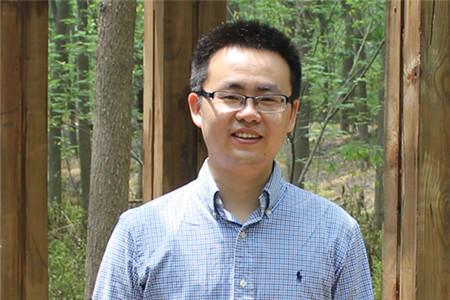
提要: “許多人都問過我,從事科研工作這么辛苦,你為何覺得有意思?我始終覺得關鍵在于興趣。”
“許多人都問過我,從事科研工作這么辛苦,你為何覺得有意思?我始終覺得關鍵在于興趣。少年班這種特殊的培養方式讓我找到了從事科學研究的興趣。”熊宇杰,這位從中科大少年班走出來的青年科學家,在談及自己的母校時,難掩自豪之情。
熊宇杰是國家首批“青年千人計劃”專家,中國科學技術大學教授、博導,1996年,年僅17歲的熊宇杰被保送進入中科大少年班學習。中科大少年班自誕生以來就充滿傳奇色彩,在中國教育界,從來沒有哪個班級像中科大少年班這樣飽受爭議。30年來,少年班在“爭議中前行”,從少年班走出來了1000多名學生,其中91%的畢業生獲得了博士碩士學位。2015年,96級少年班成員尹希晉升為哈佛大學正教授,未滿32歲,打破了他的師姐莊小威(87級少年班)創下的“34歲出任哈佛大學正教授”記錄。
在熊宇杰身上,少年班的印跡一直都存在。在少年班養成的對于科學的好奇和愛好,對他后來的科研生涯產生了潛移默化的影響。今年,熊宇杰取得多項重大突破,并獲得全國首屆“最美科技工作者”稱號和美國華人化學與化學生物學教授協會“Biomatik 杰出教授獎”,彰顯出青年科學家的卓然風采。
“少年班讓我找到了興趣所在”
1996年,年僅17歲的熊宇杰被保送進入中科大教改試點班(又稱“00班”)學習。“00班創辦于1985年,與1978年成立的少年班同屬少年班學院。我在少年班學院低年級的數學和物理課程都是和相應專業院系一起學習的,這為我目前的處于化學、物理和材料的交叉領域研究打下了堅實的基礎。”
在中科大的8年時間里,熊宇杰從無數的選擇中找到的自己的興趣所在——化學,從那之后直到現在,他一直保持著對化學的好奇、熱愛和堅持,興趣是促使他不斷創新的源泉和動力。2004年,熊宇杰從中科大博士畢業后赴美繼續博士后研究。2009年,熊宇杰加入華盛頓大學圣路易斯分校,擔任國家納米技術基礎設施組織首席研究員兼納米中心管理主任。出任該職位時,熊宇杰剛剛踏過而立之年的門檻。他坦言,華盛頓大學工作的2年多時間對他后來的研究工作影響顯著,“我當時的工作中包含了兩項重要的工作內容:在各種課題中準確找到其關鍵科學問題;和不同領域的科研人員商談可能的合作。我在這兩項工作中得到了很多體會和經驗,對于我后來的研究工作中的課題制定以及交叉合作等方面很有幫助。”
即便在美國的生活已經順風順水,熊宇杰始終沒有體會到“家”的感覺。2010年,離開故土6年后,熊宇杰回國訪問,這一次回國之行給他留下了深刻的印象,“我沒想到短短幾年間,國家發展得如此迅速,我覺得自己應該回國組建自己的科研團隊,否則余生將留下無法彌補的遺憾。”他坦言,歸屬感是觸動其回國的一個很重要的原因, 2010年底啟動的“青年千人計劃”更是為他提供了一個順理成章的理由,于是他開始聯系母校中國科技大學,在一切都準備就緒之后,熊宇杰攜妻兒動身回國。
“三位一體”合作迸發出思想火花
2011年3月,熊宇杰到中科大報到,隨即著手組建實驗室和研究組,短短半年多時間內,一個簡單的材料合成實驗室初步建成。“在實驗室建設和課題開展的過程中,我始終堅持沿著‘從簡到繁、不一蹴而就’的思路,有了自己的實驗室并初步確定研究方向之后,相應的進展就會適當地加快,目前我們團隊除了眾多研究生外,還有3名博士后,這顯然是在起步階段較難做到的。”
在之后的一年多時間里,熊宇杰不斷思考如何根據自己獨特的學術背景形成有特色的研究方向,他的研究方向也從最初的貴金屬納米結構合成發展到了目前的材料表界面調控。由于復合材料體系尤其是光催化體系相當復雜,要闡明其中的機制性問題需要通過不同學科的交叉與合作。因此,他開始和中科大的其他青年教授展開合作,并開創了“精準制備-理論模擬-先進表征”三位一體的交叉合作模式。
“平時我和江俊、張群、武曉君、宋禮等校內的年輕老師交往較多,江俊和武曉君擅長理論模擬,張群等擅長微觀過程的先進表征。我們常在用餐或業余時間聊天,擦出‘思想火花’。基于這些想法以及我自己在無機材料設計與可控合成方面的優勢,通過課題合作的形式自然形成了跨越多個學科的合作團隊。我們這些青年教授通過多學科的交叉合作,得以實現了材料合成、理論模擬和原位表征的‘三位一體’模式,對無機復合材料體系的構筑原理開展系統而深入的研究工作。正所謂‘1 + 1 > 2’,不同學科的交叉與合作使得我們可以在特定科學問題上進行深入探討。通過尋找貌似不太相同的課題之間的相同點,也會產生更多的新奇想法。”
經過研究團隊成員共同的不懈努力和交叉合作,在過去兩年,熊宇杰帶領其團隊取得了不少進展,《美國化學會志》、《德國應用化學》和《先進材料》等重要化學與材料國際期刊上報道了他們的系列科研成果,今年以來更是在太陽能轉化技術、面向燃料電池應用的催化材料設計以及新型復合光催化劑上取得重大突破。
科研工作者并非“苦行僧”
在歸國的短短4年時間里,熊宇杰從零開始,組建實驗室、招收研究生、選擇自己喜歡的課題努力深耕,在科研上連連取得突破,2015年更是交出了一份令人滿意的答卷。他坦言,這些成果的取得離不開對化學的熱愛,作為一名青年科學家,他認為自己同樣有義務和責任把這份熱情傳遞給每一位青年學子,讓更多的人燃起對科學的熱愛。
這一點充分體現在熊宇杰對于學生的培養上。熊宇杰回國后就開始帶研究生,目前在讀的有二十余人,在培養學生的過程中,他一直秉承中國傳統的“言傳身教”的理念,將做人與做學問的精神一起撒播給更多的青年學子。他認為,每一個學生都具有不同的特點,教師需要充分尊重他們的興趣,給予他們足夠的空間進行自我探索。只有在大膽嘗試和勇于探索中,他們才會發現自己的興趣點,找到從事科研的樂趣。“我在課程教學方面,也是秉承這樣一種理念去進行的。從學生們的反饋來看,大家都很喜歡這種授課方式,也有所收獲。看著自己的學生從一個極具可塑性的學生成長為具有獨立工作能力的科技工作者,是一件無比愉悅的事情。”
在美國的6年,熊宇杰學會用國際視野來看待科學問題,也使他充分認識到國際化人才培養的重要性。在培養學生時,他采取“請進來”、“送出去”兩種方式:一方面,邀請一些國際知名專家來學校做學術報告,讓學生更多地接觸到國際同行;另一方面,鼓勵學生參加國際會議或把學生通過各種國際交流項目送去國外進行聯合培養。其中,英文論文寫作被熊宇杰視為國際化人才培養的重要環節,因此他在這方面做了很多努力。“每當有實驗成果出來,我都會和學生進行面對面的溝通,為他們搭建論文框架、理清寫作思路。執筆的工作盡量讓他們自己完成。初稿出來之后,再由我來修改。”改論文是一件相當費時間的工作,熊宇杰仍然不遺余力,因為在他看來,這一環節對培養國際化人才非常關鍵。
培養學生樹立對科學的興趣是熊宇杰長期的工作理念所致,在他看來,科研工作并非“苦行”,科研工作者也并非“苦行僧”。盡管科研是占據了熊宇杰大部分的時間,他還是會把工作時間和家庭生活合理分開,盡量把晚上和周末的時間留給家人。“通過平衡科研和生活之間的關系,工作才不會成為一種負擔,而我也得以保持對科學的好奇、熱愛和堅持。作為一名父親,孩子僅有一次的成長我不想缺席,與孩子的相處對我的工作也大有裨益。每一位學生對于我來說就像一張白紙,就如同我的孩子從幼兒園進入小學需要師長的引導一樣,父親和導師這兩種角色其實有很多相似之處。”
除了陪伴家人,閑暇之余,熊宇杰也不忘和朋友們一起出行,他身邊的朋友同樣是一些青年科學家,放松與休息之余他們也會進行學術討論,而且在這種自由的環境下,討論往往會產生更具創造性的想法。
總結自己的科研之路,熊宇杰認為堅持是成功的一大秘訣,“這一點在興趣的驅動下是比較容易做到的,對化學的熱情一直是我前進的動力。另外,在學科不斷細分的趨勢下,交叉合作顯得尤為重要。因此,我會經常和同行之間進行友好、高效的交流。”與此同時,熊宇杰還十分注重社會科普工作,在他看來,科普的必要性從近年來的很多事件就可以看出,近期發生的“我們恨化學”事件就是典型的缺乏對化學的正確認識所造成的。通過社會科普,可以喚醒社會對科學的認識和興趣。
來源:千人雜志 時間: 2016-01-29
熊宇杰 納米世界盡翱翔
熊宇杰,中科大化學與材料科學學院、合肥微尺度物質科學國家實驗室(籌)雙聘教授、博導,首批國家“青年千人計劃”入選者,中科院“百人計劃”引進人才。先后榮獲全國首屆“最美青年科技工作者”,美國2015年度Biomatik杰出教授獎等榮譽。
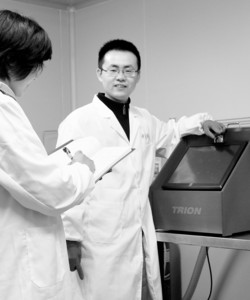
富有親和力的笑容,是熊宇杰教授給記者最深刻的印象。日前,一個陽光燦爛的午后,記者如約來到中科大東區校園。剛走進熊宇杰教授辦公室,他就迎了上來,熱情地與記者握手。如果不是提前查閱資料,你可能想不到頗有書卷氣的熊宇杰,早在32歲就入選首批國家“青年千人計劃”,36歲的他已是納米科技領域小有名氣的科學家。
熊宇杰是中科大少年班的畢業生,是個事業有成的“海歸”。在中科大謝毅院士門下讀碩士、博士,正式開啟了他的學術之路。年僅30歲,他就擔任華盛頓大學(圣路易斯)國家納米技術基礎設施組織首席研究員,并兼任納米中心管理主任。在美國,他有房有車,結婚生子,在外人看來,工作、生活都不錯。 “但在美國,我一直沒有‘歸宿感’。 ”熊宇杰笑著說,中國始終是魂牽夢繞的地方,對母校中科大,他更是有著特別的感情。
2010年,我國啟動 “千人計劃”項目,看到一些優秀人才紛紛回國,熊宇杰心動了。在導師謝毅建議下,他當年就回國考察,并于次年成功入選國家首批“青年千人計劃”。 “中科大有一批杰出的中青年教師,大家合作交流很好,國家投入也多,我的科研進展比國外同事要快得多。 ”熊宇杰坦言。
對于科研工作者來說,時間就是生命。自2011年回中科大任教后,熊宇杰立即著手建立自己的實驗室和研究組。但這時“青年千人計劃”的科研經費還沒到位,學校陸續預借了400萬元給他購買儀器設備。
“納米世界,神奇驚艷,讓我著迷。 ”熊宇杰介紹,納米科技是世界前沿,是世界各國競爭的熱點。納米材料具有傳統材料所不具備的奇異或反常的物理、化學特性,在極小的納米尺度下,固態金屬可以變得五顏六色,熔點會顯著降低。在納米世界,原本導電的銅加工到某個納米尺度就不再導電,絕緣的二氧化硅在某個納米尺度時則會變成導體。著名科學家錢學森曾預言:“納米左右和納米以下的結構將是下一階段科技發展的特點,會是一次技術革命,從而將是21世紀的又一次產業革命。 ”
神奇的納米世界,是熊宇杰愿意為之付出、為之努力的“圣地”。回國短短4年時間,聚焦納米復合材料設計與可控合成及催化性能研究,他先后在國際期刊上發表通訊作者論文36篇,其中包括《美國化學會志》《德國應用化學》《先進材料》等國際重要化學與材料科學期刊論文13篇。
自認為做研究“不是苦行僧”的熊宇杰,這么短時間為何能取得如此驕人成績? “國內科研合作一般比較困難,因為涉及成果排名問題,但中科大學術氛圍很好,我們與相關領域教授和專家合作既高效又愉快。 ”熊宇杰寥寥數語,道出了成功的關鍵。
“沒有脾氣,對于科學問題,眼光獨到。 ”談起導師熊宇杰,正讀博二的劉東如是說。在他印象中,熊老師平時話不多,但一討論科學問題,往往滔滔不絕。 “他不僅對科研大方向把握很準,對小的細節也不放過。 ”目前,劉東已在著名刊物《德國應用化學》上發表了1篇第一作者論文。去年,熊宇杰指導的一名博士生,榮獲中科院院長特別獎。
【人物感言】
科學研究不能放過任何細節,細節里可能蘊藏著重要的科學問題。熊宇杰教授在實驗室工作。
來源;安徽日報
熊宇杰:“小宇宙”爆發大能量
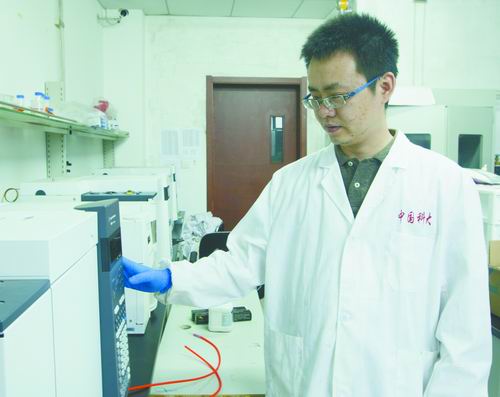
熊宇杰
這位36歲的年輕教授,回國短短幾年,就在國際期刊上發表通訊作者論文36篇,并獲香港求是科技基金會杰出青年學者獎、首屆中國化學會納米化學新銳獎、“2015年度Biomatik杰出教授獎”等榮譽。他的“小宇宙”正在爆發強盛的創新能量。
近日,中國科學技術大學教授熊宇杰榮獲美國華人化學與化學生物學教授協會頒發的“2015年度Biomatik杰出教授獎”,該獎項每年只頒發兩人。
這位年輕教授回國短短幾年時間,先后獲香港求是科技基金會杰出青年學者獎、首屆中國化學會納米化學新銳獎、中國化學會青年化學獎、中國科學院優秀導師獎、首屆“最美青年科技工作者”等榮譽。
回國才有歸宿感
在熊宇杰36年的人生歷程中,他的成長仿佛正應了“宇杰”二字——才華卓爾,天下俊杰。
早先,熊宇杰是中科大少年班的畢業生,后來在中科大謝毅院士門下攻讀碩士、博士。2004年,熊宇杰提前一年獲得中科大無機化學博士學位,赴美國華盛頓大學(西雅圖)做博士后研究,師從著名材料學家夏幼南教授。三年后,任美國伊利諾伊大學香檳分校材料與科學工程系助理研究員,在美國工程院和科學院院士John Rogers教授實驗室工作。
由于突出的科研表現,2009年,年僅30歲的熊宇杰擔任華盛頓大學(圣路易斯)國家納米技術基礎設施組織首席研究員,并兼任納米中心管理主任。
此時的他已結婚生子,在美國買了房子,工作和生活都順順當當。但熊宇杰內心深處卻感覺空落落的,找不到“歸宿”感。恰在此時,我國啟動“千人計劃”項目。看到一些優秀人才紛紛回國,熊宇杰也開始思考去留問題。但由于在外多年,他對國內科研形勢不太了解,一時猶豫不決。謝毅教授獲悉后,建議他先回來看看。
“我2010年3月回母校,看到科研條件、發展態勢都很好,感到在國內也能做出好成果,就決定回來了。”熊宇杰告訴《中國科學報》記者。同年年底,他入選中科院“百人計劃”,次年3月到中國科大報到,8月入選國家首批“青年千人計劃”。
熊宇杰的科研領域是面向能源問題的納米復合材料設計與可控合成及催化性能研究。回國后,他立即著手組建實驗室和研究組。但這時“青年千人”的科研經費還沒到位,學校陸續預借了400萬元給他購買儀器設備。只半年多時間,實驗室初步建成。
“科大有一批水平很高的中青年教師,大家合作交流很好,國家投入也多,我的科研進展比國外同事要快得多。”熊宇杰說,對此他有一種“滿足感”。
交叉合作結碩果
有了實驗室這個平臺之后的熊宇杰更顯如虎添翼。不算回國第一年建實驗室的時間,僅用三年時間,他就在國際期刊上發表通訊作者論文36篇,其中包括《美國化學會志》《德國應用化學》《先進材料》等國際重要化學與材料科學期刊論文13篇。真可謂“小宇宙爆發”。
自認為做研究“并不算刻苦”的熊宇杰,何以在短時間取得如此驕人成績?他告訴記者,“首先是學校支持多,實驗室建得快”。其次,得到了學校很多資深教授的支持和指導,經常和謝毅、羅毅這些國際知名學者探討科學問題,逐步領會到跨領域科學研究的重要性。“第三,主要是認識了一批研究興趣相投的教授,各種合作方向的老師都能找到”。
回國后,熊宇杰與江俊、張群、武曉君、宋禮等校內年輕教師交往較多,江俊和武曉君擅長理論模擬,張群等擅長微觀過程的先進表征。他們常在食堂用餐或業余時間聊天,擦出“思想火花”,于是就開展“精準制備-理論模擬-先進表征”三位一體的交叉學科合作研究。
“盡管我本科學的是化學物理專業,屬于交叉學科,但對一些原理的理解還是膚淺。與他們經常討論,不斷加深理解,這對我設計材料很有好處。”熊宇杰說,材料設計好后,再請做表征的老師來驗證,這樣更容易產生設計和驗證的方法。采取這種交叉研究,前不久他們在英國皇家化學會《化學會評論》上發表了一篇綜述論文。
“國內科研合作一般比較困難,因為涉及成果排名問題,但科大的學術氛圍不錯,我們合作得很高效、愉快。”熊宇杰說。
平和細心的導師
極富親和力,是作為導師的熊宇杰給學生最深刻的印象。
讀博二的劉東,已在《德國應用化學》上發表了一篇第一作者論文,目前還有兩篇國際論文準備投稿。在他印象中,熊老師平時話不多,但一討論科學問題,往往滔滔不絕。“他不僅對科研大方向把握的很準,對小的細節也不放過,他總是說細節可能蘊藏著重要的科學問題”。尤其讓劉東感到高興的是,熊老師為人很平和,“從沒發過脾氣,與他交流比較輕松,敢于大膽說出自己不成熟的想法。”
熊宇杰回國當年即開始帶研究生,去年畢業的一名博士生獲中科院院長特別獎,今年又將有4名博士和一名碩士研究生畢業,目前在讀的十余人,他們都表現出較強的創新能力,原創成果不斷涌現。
說起來,熊宇杰指導研究生也經歷了一個過程。回國頭兩年,為加快進展,設計實驗流程、分析數據、寫論文,熊宇杰往往親力親為。但后來發現,這對學生的能力培養不利,于是就花更多時間與學生討論交流,更多的讓他們動手。
研究生入學伊始,熊宇杰都要與他們一一面談,了解其興趣愛好,然后確定研究方向和課題,介紹相關前沿文獻讓他們研讀。課題開始簡單,等做出成果、學生的興趣和自信增強后,逐步加大難度。
熊宇杰和學生們交流、互動有一個規定安排,叫“兩會”——每周一、周三上午是一對一的見面會,每次安排4~5名同學依次面談,及時了解學生的科研進展,討論存在的困難和問題,以及下一步工作如何開展;組會則是安排在每周二晚上,所有研究生一起參加,一次4~5人依次用PPT做報告,介紹自己課題的背景、研究進展、潛在的問題等,然后大家提出問題,進行討論。熊宇杰每次都參加討論,點評報告,提出改進意見,“目的是培養學生的表達交流能力,因為做好學術報告是今后從事學術研究的必備素質”。
英文論文寫作是國際化人才培養的重要環節。實驗成果出來后,熊宇杰講清寫作思路和框架,盡量讓學生拿初稿,然后他來修改。“盡管改起來很費時間,有的甚至要改幾十稿,但對培養國際化人才很有必要”。
來源:中國科學報 2015年06月12日
中科大教授熊宇杰:回國才有“歸宿感”
中科大熊宇杰教授榮近日獲美國華人化學與化學生物學教授協會頒發的“2015年度Biomatik杰出教授獎”。據悉,該獎項每年只頒發給兩人。
25日,這位36歲的年輕教授向媒體透露,回國短短幾年時間,先后獲香港求是科技基金會杰出青年學者獎、首屆中國化學會納米化學新銳獎、中國化學會青年化學獎、中國科學院優秀導師獎、首屆“最美青年科技工作者”等榮譽的秘訣,談自己的“歸宿感”。
回國才有了“歸宿感”
2004年,熊宇杰提前一年獲得中科大無機化學博士學位,赴美國華盛頓大學(西雅圖)做博士后研究,師從著名材料學家夏幼南教授。三年后,任美國伊利諾伊大學香檳分校材料與科學工程系助理研究員,在美國工程院和科學院院士JohnRogers教授實驗室工作。由于突出的科研表現,2009年,年僅30歲的他就擔任華盛頓大學(圣路易斯)國家納米技術基礎設施組織首席研究員,并兼任納米中心管理主任。
當時,熊宇杰已結婚生子,在美國工作生活都不錯。但他內心深處,一直有種沒有“歸宿”的感覺。恰好,中國啟動“千人計劃”項目,看到一些優秀人才紛紛回國,熊宇杰開始思考去留問題。由于在外多年,對國內科研形勢不太了解,一時猶豫不決。
“我2010年3月回母校,看到科研條件、發展態勢都很好,感到在國內也能做出好成果,就決定回來了。”熊宇杰說。當年底,他入選中科院“百人計劃”,次年3月到中科大報到,8月入選國家首批“青年千人計劃”。
回國后,熊宇杰立即著手建實驗室和研究組。但這時“青年千人”的科研經費還沒到位,學校陸續預借了400萬元人民幣給他購買儀器設備。只半年多時間,實驗室初步建成。
看到自己科研進展迅速,熊宇杰說,對此他有一種“滿足感”。
“三位一體”的交叉合作
熊宇杰的科研領域是面向能源問題的納米復合材料設計與可控合成及催化性能研究。刨去回國第一年建實驗室,僅三年時間,他在國際期刊上發表通訊作者論文36篇,其中包括《美國化學會志》、《德國應用化學》、《先進材料》等國際重要化學與材料科學期刊論文13篇。
在他看來,這與學校、以及很多資深教授的支持和指導分不開,他常和謝毅、羅毅這些國際知名學者探討科學問題,逐步領會到跨領域科學研究的重要性。
此外,在中科大“各種合作方向的老師都能找到”,熊宇杰與江俊、張群等校內年輕教師交往較多。他們常在食堂用餐或業余時間聊天,擦出“思想火花”,于是就開展“精準制備-理論模擬-先進表征”三位一體的交叉學科合作研究。他說,采取這種交叉研究,前不久他們在英國皇家化學會《化學會評論》上發表了一篇綜述論文。
來源:中國新聞網 2015年05月25日17:32
中國科技創新人物云平臺暨“互聯網+”科技創新人物開放共享平臺(簡稱:中國科技創新人物云平臺)免責聲明:
1、中國科技創新人物云平臺是:“互聯網+科技創新人物”的大型云平臺,平臺主要發揮互聯網在生產要素配置中的優化和集成作用,將互聯網與科技創新人物的創新成果深度融合于經濟社會各領域之中,提升實體經濟的創新力和生產力,形成更廣泛的以互聯網為基礎設施和實現工具的經濟發展新形態,實現融合創新,為大眾創業,萬眾創新提供智力支持,為產業智能化提供支撐,加快形成經濟發展新動能,促進國民經濟提質增效升級。
2、中國科技創新人物云平臺暨“互聯網+”科技創新人物開放共享平臺內容來源于互聯網,信息都是采用計算機手段與相關數據庫信息自動匹配提取數據生成,并不意味著贊同其觀點或證實其內容的真實性,如果發現信息存在錯誤或者偏差,歡迎隨時與我們聯系,以便進行更新完善。
3、如果您認為本詞條還有待完善,請編輯詞條。
4、如果發現中國科技創新人物云平臺提供的內容有誤或轉載稿涉及版權等問題,請及時向本站反饋,網站編輯部郵箱:kjcxac@126.com。
5、中國科技創新人物云平臺建設中盡最大努力保證數據的真實可靠,但由于一些信息難于確認不可避免產生錯誤。因此,平臺信息僅供參考,對于使用平臺信息而引起的任何爭議,平臺概不承擔任何責任。

